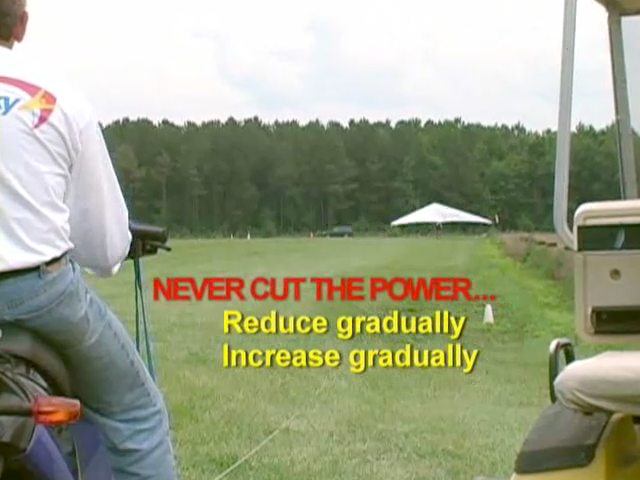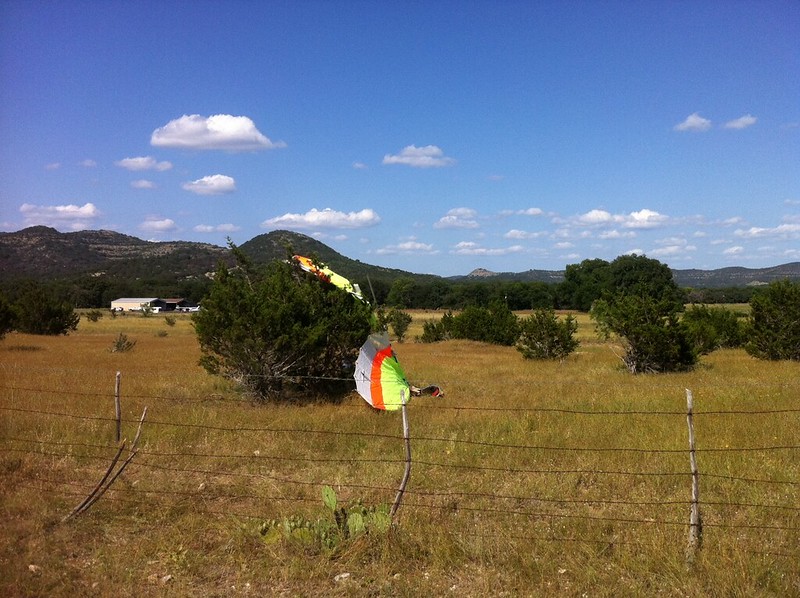http://www.ushawks.org/forum/viewtopic.php?f=17&t=1081
Platform towing /risk mitigation / accident
Bill Cummings - 2012/07/18 05:45:32 UTC
Lets speculate then.
Oh, let's add a few rumors first.
- 2012/06/16, approximately 16:40 CDT.
- Terry James Mason
-- 1946/01/16-2012/06/16
-- Leakey, Texas
-- 140 pounds
-- 31982, Hang 3, 2011/07/22, Sam Kellner
-- Real County Airport, 49R, Runway 15, Leakey, Texas
- Terry's platform rig.
- Martin Doesn't-Believe-In-Hook-In-Checks Almost-Killed-In-Lockout-On-Sam's-Platform-Rig Apopot driving.
- Sam No-You-Don't-Get-An-Accident-Report Kellner riding on the back with his hand on the hydraulic pressure lever poised to make a good decision in the interest of the pilot's safety.
- Wind - SSE, straight down the runway, at around twelve, increasing substantially with altitude.
- Terry - as per his usual practice 'cause he was always more interested in experiencing the incomparable thrill of free flight than he was about getting the basics down on scooter tow to make the incomparable thrill of free flight less thrilling - oscillates his Sport 2 135.
- When Terry is at about 75 feet and maxing out one of his oscillations to the right, Sam makes a good decision in the interest of the pilot's safety...
http://www.hanggliding.org/viewtopic.php?t=20597
Noobie
Sam Kellner - 2011/01/24 12:49:32 UTC
Blue Sky is among the best.
Wills Wing / Blue Sky / Steve Wendt / Ryan Voight Productions - 2007/03
NEVER CUT THE POWER...

Reduce Gradually
Increase Gradually
...and Terry experiences the incomparable thrill of free flight...
http://farm9.staticflickr.com/8143/7462005802_bbc0ac66ac_o.jpg

...one last time for a couple seconds.
- Well, he's still connected on impact but the pressure's been dumped so what the hell.
As a thirty four and a half year, towing experience, pilot I know what a lockout is.
I often smirk when I hear of a center of mass lockout.
1. Yeah, Bill. Lockouts became things of the past when Donnell introduced the center of mass towing system concept - UNLESS:
- the pilot was stupid enough to stay on tow until contact with a downtube or nose wire was made by the pilot or bridle; AND
- a weak link in excess of one G - the combined weight of pilot and glider - was used.
2. There's no such thing as center of mass towing. All modern towing routes the tow tension to or a bit in front of the hang point.
Unless you have used a Moyes stainless steel towbar, towing from the base tube, you really have know concept of what a lockout REALLY is.
Bullshit. You can get overwhelmed my misaligned tow tension using any configuration you care to use, locked out, and killed just as dead as you could back in the old days. Sometimes even more dead because back in the old days nobody used releases which stank on ice.
That said, you can loose control while under tow, center of mass, for a host of reasons.
Including...
- the fact that a hang glider under tow is inherently roll unstable
- flying in thermal conditions
- having some total moron of an instructor teach you that there is a cone of safety
- not having learned how to fly your glider
- a tow operator who makes a good decision in the interest of your safety
- a standard aerotow weak link which will break before you can get into too much trouble
- a release within easy reach
- attempting to fly a glider with one hand during an emergency
- a new and improved Lookout Release not warranted as suitable for towing anything
- thinking that a pro will no longer have any use for the top third of his speed range
- having a fin stabilize you in a direction you'd rather not be flying
All of the reasons are more forgiving with center of mass towing.
How much more dead is Joel Lewis (1981/04/12) than Frank Sauber (1996/04/28)?
Rules of thumb like, while towing in a crosswind point your gliders nose at the tow vehicle, work with a constant wind vector throughout the ascension to release altitude.
Leave the glider alone and it will pretty much point itself where it should be.
If you pay attention you will see your towline with a slight "S" curve, look to it on days when you are towing through vector changes, with accompanying shears, that will require you to not have your nose pointed at the tow vehicle during a crosswind tow. I would guess that about better than 90% of the tow pilots have never thought past the, "Point you gliders nose at the tow vehicle while towing in a crosswind," --rule of thumb.
In that situation you will find yourself constantly dropping a wing to the same side until you simply have to pin off.
Why? --You are not towing in the "Sweet Spot."
Why? --because you don't yet know how to read the rope and put yourself in the, "Sweet Spot,"
Why? --Because you are pointed at the truck and not the relative wind while crabbing down the tow road to the downwind side of the tow vehicle.
And as you yourself have pretty much just told us, when issues like these become factors you're highly likely to be so high that we're no longer talking about safety issues.
You can only figure this out (being in the sweet spot) once you embrace the fact that the rule of thumb only works in an air steady state situation. (How many time will we find that happening while towing?)
Within the kill zone? Pretty much always.
And another thing, -- darn it!-- What is with all the Youtube video's of experienced tow people dashing out from under the glider and paying out rope until the tow vehicle has a fifteen degree angle on the tow line to the ground?
If you want to do that use a rope to the keel so it won't wallow and tip stall because of too much angle of attack. (AOA).
No thanks.
- It's a little better than one point aerotowing to start with.
- If you get popped up or rolled the tension is constant so you're a whole lot more likely to be able to keep things together.
- The situation keeps improving with tow angle.
- When you start getting to high tow angles the upper bridle leg starts becoming a royal pain.
Center of mass (to the pilot only) works best if you keep the pilot anywhere from about thirty five degrees to forty five degrees angle to the surface.
Yes. But zillions of people aerotow one point at zero degrees tow angle and only have serious problems when nobody looks at or has ribbons and - even then - on only extremely rare occasions.
The argument that you want to tow the pilot ahead and not down does not hold up especially if you have a low airtime tow pilot on the line. The trim feel will not be there. It will stall a tip easy with a low airtime pilot.
Fine. Then don't tow low airtime pilots using that technique.
Sure, a long time tow pilot can hold in on the base tube to keep it from stalling a tip...
ANYBODY can hold in on the basetube to keep it from stalling a tip - or anything else. You don't hafta be Chuck Freakin' Yeager to hold the bar back.
...while towing with a poor angle. But why?
Low AIN'T a poor tow angle. Zero is an EXCELLENT tow angle - all forward thrust and nothing aiding gravity to pull you back down. The steeper your tow angle the less efficient will be your climb.
Fly the correct angle on the towline and tow up at trim. Safety should win out over efficiency all the time.
Bullshit. Damn near everything in aviation is a tradeoff and there are issues of degrees.
- More efficient GLIDERS are damn near all more dangerous than the baggy stuff.
- If we want mile wide safety margins we shouldn't tow in soarable conditions.
- One more efficient tow with narrower safety margins that gets you to workable altitude is safer than towing twice with less efficiency and narrower safety margins to get the job done.
- If you're so fuckin' worried about safety margins then spend a couple hundred bucks to develop an electronically actuated release which blows the bridle off your hips with the push of a button.
- Having assholes like Sam and Bob stood up against walls and shot would also do wonders for safety in this sport.
It's late. More later on being in the sweet spot while towing.
The sweet spot ain't always that sweet. The air can do funny things to move it away very far very fast.
This post is only to point out how to avoid loss of control while towing and is not related to Terry's accident since I don't know what his control problem was.
1. It's not really related to ANY "accidents". It's mostly related to towing efficiency and tradeoffs.
2. Terry didn't have an ACCIDENT.
3. One of Terry's control problems was that he couldn't be bothered to learn to fly his glider in a safe environment.
4. But I'd be happy to bet fifty bucks that what actually pushed him over the edge was...
Manned Kiting
The Basic Handbook of Tow Launched Hang Gliding
Daniel F. Poynter
1974
"A bad flyer won't hurt a pin man but a bad pin man can kill a flyer." - Bill Bennett
...hooking up behind a bad pin man who couldn't be bothered to learn that...
Manned Kiting
The Basic Handbook of Tow Launched Hang Gliding
Daniel F. Poynter
1974
"The greatest dangers are a rope break or a premature release." - Richard Johnson
...the greatest dangers are rope breaks and premature releases.
And we had tons of evidence before 2012/06/16 and lots more evidence afterwards that Terry's pin man totally sucked and still does.



